
Pinewood Studios is a British film and television studio located in the village of Iver Heath, England. It is approximately 18 miles (29 km) west of central London.

The Southern Railway (SR) gave the designations 4-COR, 4-RES, 4-BUF and 4-GRI to the different types of electric multiple unit built to work the route between London Waterloo and Portsmouth Harbour. The 4-COR type units survived long enough in British Rail ownership to be allocated TOPS Class 404. The COR designation had previously been used for the 6-PUL units and was reused by them during World War II when the Pullman car was stored, but this stock was different from the 4-COR units.

The British Rail Mark 3 is a type of passenger carriage developed in response to growing competition from airlines and the car in the 1970s. A variant of the Mark 3 became the rolling stock for the High Speed Train (HST).

The SR Class 4DD was an experimental double-decker electric multiple unit built in 1949 and operated by the Southern Railway until 1971. Conceived by Oliver Bulleid for the Southern Railway's commuter line from London Charing Cross to Dartford, the two trains were the only double-decker trains to be used on the mainline railway network in Britain. Whilst commonly used in continental Europe and North America, the restrictive railway loading gauge in the United Kingdom prohibits normal double-decker trains with two fully separated decks.

The Harris trains were the first steel-bodied electric multiple unit (EMU) trains to operate on the suburban railway network of Melbourne, Victoria, Australia. They were introduced in 1956, by the Victorian Railways, and last operated in 1988, although a number of the carriages were converted for other uses and are still operating. They were named after Norman Charles Harris, Chairman of Commissioners of the Victorian Railways, between 1940 and 1950.

Littlehampton railway station is in Littlehampton in the county of West Sussex, England. The station and the trains serving it are operated by Southern.

The Albert R. Broccoli 007 Stage is one of the largest sound stages in the world. It is located at Pinewood Studios, Iver Heath, Buckinghamshire, England, and named after James Bond film producer Albert R. "Cubby" Broccoli.
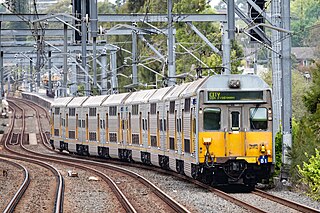
The Sydney Trains K sets are a class of electric multiple units that currently operate on the Sydney Trains network. Built by A Goninan & Co, the K sets first entered service in 1981 operating under the State Rail Authority, and later CityRail. The carriages are of stainless steel, double deck construction and share much of their design with the older S sets. All of the 40 K sets originally built remain in service and are currently the oldest in the Sydney Trains fleet.

The British Rail Class 318 is an electric multiple unit (EMU) passenger train which operates in west central Scotland. The units were introduced on 29 September 1986 as part of the electrification of the Ayrshire Coast Line between Glasgow Central and Ayr/Ardrossan with alternating current (AC) overhead lines. Their use was extended to Largs in January 1987. They were also used on the Inverclyde Line in small numbers. The trains currently operate Argyle Line, Cathcart Circle Line, North Clyde Line, Whifflet Line and Inverclyde Line services. Following the withdrawal of the Class 314 fleet in 2019, these units are the oldest working EMUs in Scotland, having been in revenue-earning service for more than 37 years.

The British Rail Class 306 was a fleet of electric multiple unit (EMU) trains introduced in 1949. It consisted of 92 three-car trains which were used on the Great Eastern Main Line between Shenfield and London Liverpool Street.

The British Rail Class 506 was a 3 carriage electric multiple unit (EMU) built for local services between Manchester, Glossop and Hadfield on the Woodhead Line, which was electrified in 1954 on the 1,500 V DC overhead system.

The V/Line VLocity, sometimes called the VLocity 160, is a diesel multiple unit train built by Alstom in Dandenong for V/Line, the regional rail operator in the Australian state of Victoria. Continuously in production since 2003, the VLocity is the highest-speed train in the V/Line fleet, with a top speed of 160 km/h (99 mph). As of December 2023 with set 114 entering service, 112 3-car sets are in revenue service, 2 collision damaged sets are in storage, and 5 more are under construction on the current order with a further 23 sets confirmed on the next order
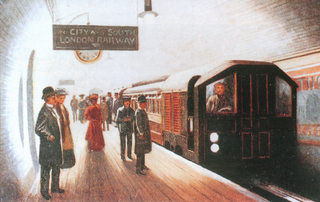
The Central London Railway Stock were electric multiple units composed of trailers that had been converted from carriages designed to be hauled by electric locomotives with new motor cars. The Central London Railway opened in 1900 with electric locomotives hauling wooden carriages, but the heavy locomotives caused vibrations that could be felt in the buildings above the route. It was found that conversion to electric multiple units solved the problem, so new motor cars were bought and replaced all the locomotives by June 1903. Trains normally ran with six-cars, four trailers and two motor-cars. Some trailers were equipped with control equipment to allow trains to be formed with three cars.
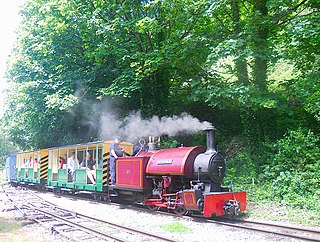
The Amberley Museum Railway is a 2 ft narrow gauge railway based at Amberley Museum, Amberley, West Sussex. It has a varied collection of engines and rolling stock ranging from 18 in gauge to 5 ft 3 in gauge. It operates passenger trains at the museum using a mixture of steam, internal combustion and battery-electric locomotives.
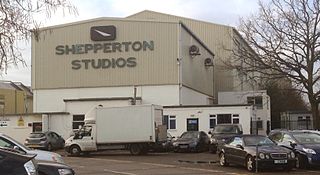
Shepperton Studios is a film studio located in Shepperton, Surrey, England, with a history dating back to 1931. It is now part of the Pinewood Studios Group. During its early existence, the studio was branded as Sound City.

Two models of South Australian Railways Brill railcar operated by the South Australian Railways between 1925 and 1971. Introduced to run on country rail services, the "Barwell Bulls" serviced most of the state's railway lines until they were eventually replaced by both the Bluebird and Redhen railcars. The last units were withdrawn in 1971.
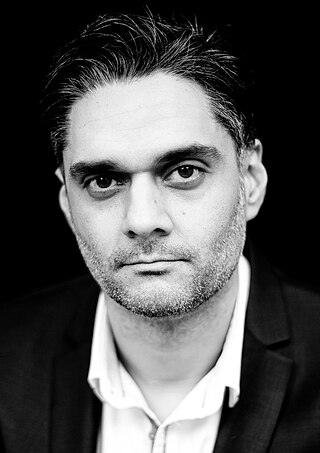
Omid Nooshin was an English film director and writer. He was best known for his debut independent feature film Last Passenger.
The 16th British Independent Film Awards, held on 8 December 2013 in London, were hosted by James Nesbitt. The awards honoured the best British independent films of 2013.

The class 3SUB were DC suburban electric multiple units introduced by the London and South Western Railway in 1915 and constructed by the Southern Railway in the period up to 1939. The class designation 3SUB was not used by the Southern Railway, although some authors refer to these units as 3SUB. When rebuilt to four cars in the 1940s, they became class 4SUB.

The Commuter is a 2018 American action thriller film directed by Jaume Collet-Serra and written by Byron Willinger, Philip de Blasi and Ryan Engle. The film stars Liam Neeson, Vera Farmiga, Patrick Wilson, Jonathan Banks, Florence Pugh, and Sam Neill. It follows a man who is unwittingly recruited into a murder conspiracy after meeting a mysterious woman while on his daily train commute.




















